Blockchain Design Thinking at Micropole
At Micropole Consulting Belgium, we have a team of 4 blockchain enthusiasts working on various projects related to the implementation of blockchain in entreprises. We help our clients in implementing a blockchain and we help them in identifying whether and where a blockchain can solve business problems. We quickly realized that although many people have heard of blockchain and maybe have assisted to presentations dedicated to the subject, they are still not clear about the technology, the advantages it can bring to their infrastructure, the areas of their business where a blockchain would make the more sense. We want to educate our clients on the subject. But rather than giving them another presentation and throw at them technical terms and hyped ideas, we came up with another approach. We organize with them a two-day Blockchain Design Thinking session.
Design Thinking
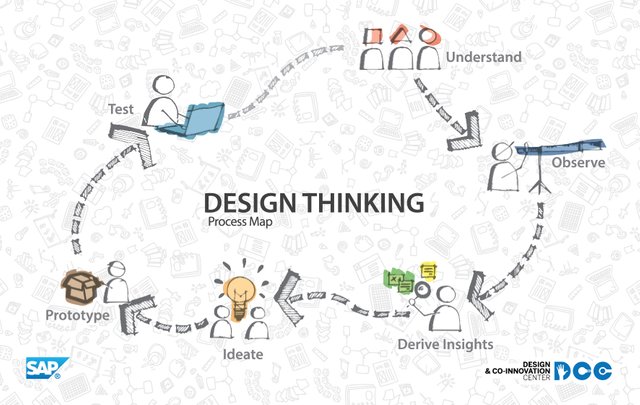
Design Thinking is a modern approach to innovate and solve problems. I'll borrow from people who describe it better than me (ideou.com):
Design thinking is a process for creative problem solving.
Design thinking utilizes elements from the designer's toolkit like empathy and experimentation to arrive at innovative solutions. By using design thinking, you make decisions based on what future customers really want instead of relying only on historical data or making risky bets based on instinct instead of evidence.
Design thinking relies on the human ability to be intuitive, to recognize patterns, and to construct ideas that are emotionally meaningful as well as functional. The elements of design thinking combine to form an iterative approach—one you can try out and adapt to suit your needs. (...) design thinking is not a linear path, "it's a big mass of looping back to different places in the process."
Blockchain Design Thinking at Micropole
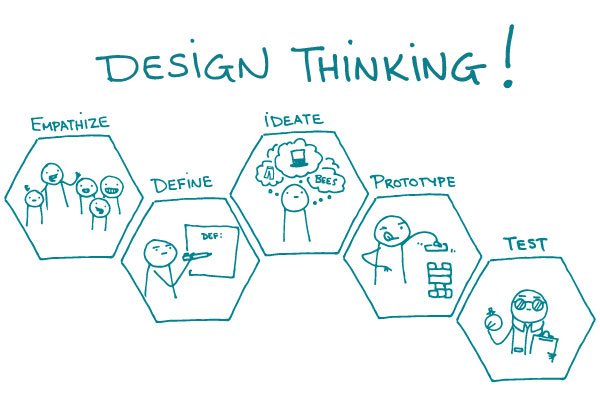
Our Blockchain Design Thinking program is a two-day session. Is is held with a single company around its business processes or with multiple companies from the same industry. The participants include business and/or IT C-levels of the compan-y(-ies), other actors from the same industry, several blockchain experts from Micropole, a Design Thinking facilitator and a visual facilitator (to sketch and visualize the discussion and business processes).
All those participants will take part in the first day. The second day will only involve the blockchain experts and the Design Thinking facilitator.
The first day is organized as follows:
A blockchain expert gives a presentation about blockchain technologies and how they can be applied to business processes. Some examples of use cases are described. The industry participants can ask questions or request more explanation on specific topics.
Through various activities, the Design Thinking facilitator makes all participants draw and grasp the industry business processes and identify the areas with problems or whith potential for innovation.
The business processes are studied in light of blockchain technologies. Areas where problems can be solved by blockchain are identified.
A small set of problems are selected by the participants and implementation of blockchain is studied further.
Only Micropole's blockchain experts and the Design Thinking facilitator take part in the second day. The industry participants have a day off ;-). The purpose of the second day is to launch the development of a prototype:
From the ideas identified during the first day with the industry participants, the blockchain experts pick the one that is the most suitable for a blockchain implementation.
Following the Design Thinking philosophy and guidelines, a Minimum Viable Product (MVP) is conceptualized and its value proposition is studied.
The basic features of the MVP are documented and the development of this prototype is kicked off.
Following the two-day Design Thinking sessions, a prototype is developed within 2-3 weeks for testing by the industry participants. If successful, implementation is proposed.
Blockchain Design Thinking for the Real Estate industry
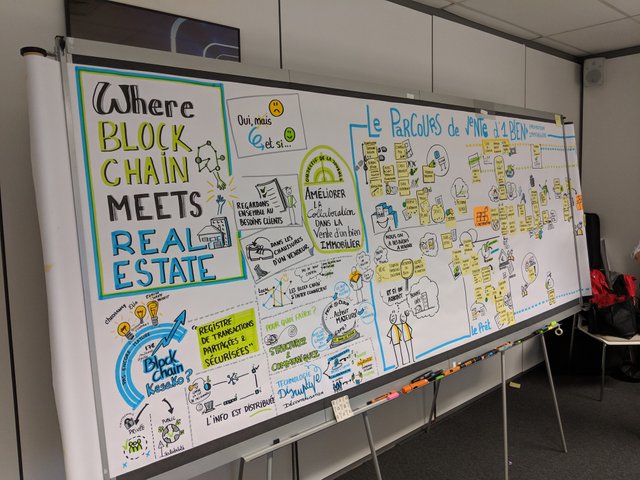
Our first Blockchain Design Thinking session was dedicated to the Real Estate industry. The participants included:
- The IT directors and architects from two of the biggest Real Estate companies in Belgium;
- Two bankers;
- A notary;
- A Design Thinking facilitator;
- A visual facilitator;
- Four blockchain experts and consultants from Micropole Belgium.
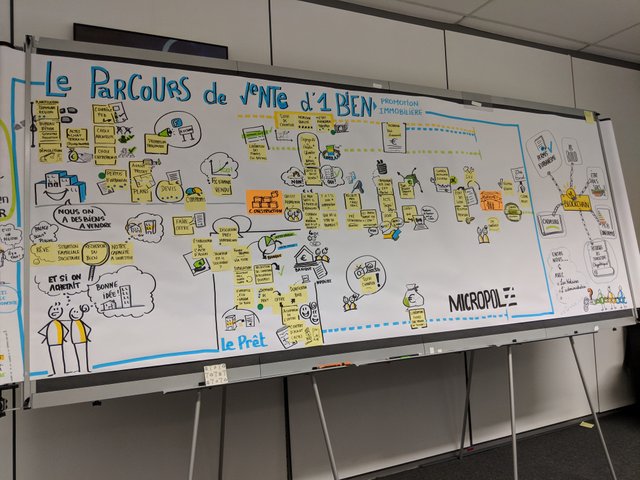
The session revolved around the process of the sale of a property and the Design Thinking facilitation led us to a clear map of all the steps involved in the process. As the sale of a property concerns many different parties, we identified multiple areas where the implementation of a blockchain would make sense and improve the collaborations and processes. Two blockchain implementations were selected for further study, and one of them led to a prototype. They are briefly explained below.
A ledger of all lands and properties in Belgium
There are so many important documents and information regarding real estate properties that are really important but none of them is kept at the same place. Many of them do not even exist in a digital form. Everytime you need a document, you wonder where to go and who to contact. Good luck finding you way in the mazes of the Belgian administration. Those pieces of information include:
- The building permit
- The soil condition
- The cadastre
- The as-built blueprints
- The history of building modifications
- The certifications of the electrical installation, the boilers, the tanks, the PEB,...
- The history of the previous owners
- ...
It would make a lot of sense to have all those pieces of information digitalized and easily accessible (some with private access) from a single location. This was very difficult to consider prior to blockchain technologies because of the many different involved parties and sources of information. No single entity should be owner and responsible for all this sensitive information. A blockchain is the perfect tool to support such a gathering of data and a decentralization of the trust and the responsibilities.
As-built
From the first blueprint of the building to the painting of the last room, there usually are many modifications that are not always perfectly tracked. What we call the as-built blueprint is the blueprint delivered at the end of the construction, and that includes the initial blueprint plus all the modifications. The as-built should serve as a good representation of the final state of the building. Often it is not. Communication between the real estate developer, the architect, the building supervisor, the construction workers, and all the other parties that are involved in the building phase, is not always perfect. Each party has his interests, priorities, and more often than not, their interests are not aligned. That communication usually happens over the phone or over emails. It is difficult to track the discussions, the documents, the decisions.
A digital platform to support all communications regarding the construction of a building would quickly prove benefitial. The problem is that when the actors are big companies, they usually do not want to rely entirely on a system administered by one of their counterparts, and specially for such sensitive information. Again, that is where a blockchain fits the bill. There is no single admin of the system and no actor can cheat the others.
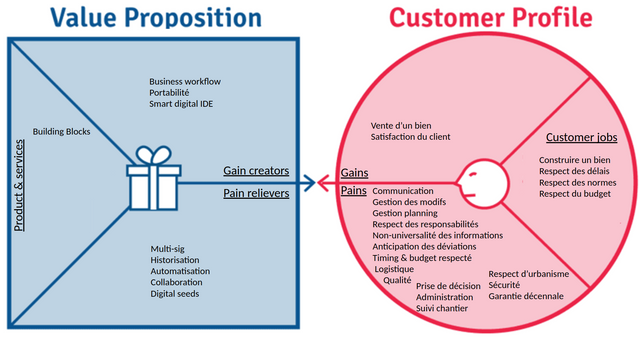
After a Value Proposition Design exercise, it was decided to develop an MVP of a private blockchain to demonstrate this use case. The Building Block platform is born. This simplified prototype allows the formalization of communication and decision taking between three independant parties collaborating on a construction project.
The value proposition of the Building Block platform:
Our solution Building Block helps the real estate developer in following its construction site, by historizing every modification and decision, formalizing the decision-making process, making more fluid the exchange of information and documents between the parties and ensuring their traceability; leading to portability and transparency of data and streamlining the business workflow; unlike systems based on traditional DBs, exchanges of emails and paper documents, and conventional digital data storage systems (Dropbox, Sharepoint,...).
As explained above, this prototype represents the follow-up to the Blockchain Design Thinking process that we proposed to the clients we have in the Real Estate industry.
As a conclusion, I would just add the following realization that we had after the first Blockchain Design Thinking session: The industry participants came to the session thinking they "knew" what a blockchain was. They left really grasping what it is and what we can achieve with it.
If you are interested in what we do and would also like to really grasp what a blockchain is and how it can revolutionize some of your business processes, do not hesitate to contact me.
Join the forward thinking people who receive the Micropole Blockchain Tribe monthly newsletter - subscribe now. You'll get a small curated selection of the best articles about Blockchain for Entreprises and you will be kept updated with our activities and developments.
Interesting Use Case :-)